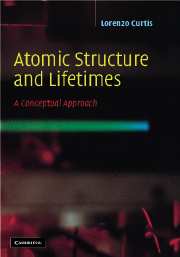Book contents
- Frontmatter
- Contents
- Preface
- List of physical constants and useful interrelations
- 1 Introduction
- 2 Semiclassical conceptual models
- 3 Semiempirical parametrization of energy-level data
- 4 The vector model of angular momentum
- 5 The intermediate coupling model
- 6 Electric dipole radiation
- 7 Line strengths in two-valence-electron systems
- 8 Magnetic dipole transitions
- 9 Absorption of radiation
- 10 Time-resolved measurements
- 11 Hyperfine structure
- 12 Electrostatic polarizabilities and long-range interactions
- 13 Coherence and anisotropic excitation
- References
- Index
7 - Line strengths in two-valence-electron systems
Published online by Cambridge University Press: 06 July 2010
- Frontmatter
- Contents
- Preface
- List of physical constants and useful interrelations
- 1 Introduction
- 2 Semiclassical conceptual models
- 3 Semiempirical parametrization of energy-level data
- 4 The vector model of angular momentum
- 5 The intermediate coupling model
- 6 Electric dipole radiation
- 7 Line strengths in two-valence-electron systems
- 8 Magnetic dipole transitions
- 9 Absorption of radiation
- 10 Time-resolved measurements
- 11 Hyperfine structure
- 12 Electrostatic polarizabilities and long-range interactions
- 13 Coherence and anisotropic excitation
- References
- Index
Summary
All that is not forbidden is obligatory.
Relativistic E1 transitions
In a complex atom or ion, the only rigorous constraints that are imposed on radiative transitions between levels are those of conservation of energy, conservation of angular momentum, and conservation of parity. For electric dipole transitions, conservation of parity leads to “Laporte's rule,” which states that the parity of the atom must change because the E1 photon carries away one unit of parity. For a single out-of-shell electron, the parity is given (nonrelativistically) by (−1)l and the angular momentum is given by j = l ±½. Thus it is not possible for two different levels with the same parity to also have the same total angular momentum. For systems with multiple out-of-shell electrons it is possible for two levels with the same parity to have the same total angular momentum, and the eigenvectors of these levels can (and in real cases always do) contain an admixture of other LS quantum numbers. In the simplest LS formulation (nonrelativistic E1), this mixing is neglected, and the spectrum consists of levels of noninteracting multiplicities (singlets and triplets for two valence electrons, doublets and quartets for three-valence-electron systems, etc.). If the exact LS-coupling assumption is relaxed, the individual multiplicity amplitudes in the admixtures lead to E1-allowed “intersystem” or “intercombination” (relativistic E1) transitions between the levels despite their nominal LS labels.
Selection rules
The fact that an E1 photon carries away one unit of angular moment and one unit of parity imposes the selection rules on the atom ΔJ = 0,±1 (no 0→0), ΔMJ = 0,±1 (no 0→0), with a parity change.
- Type
- Chapter
- Information
- Atomic Structure and LifetimesA Conceptual Approach, pp. 138 - 163Publisher: Cambridge University PressPrint publication year: 2003



